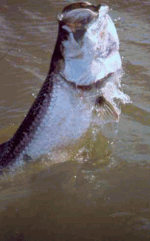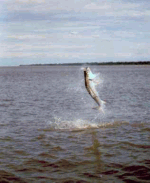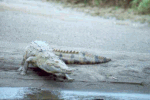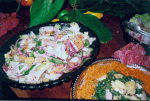by Mary L. Peachin with photography by Raymond Berry and Mary L. Peachin
Jul 2001, Vol. 5 No. 9
 “Hey, Mom! Did you see The Perfect Storm?” Suzie, her stomach churning, groaned under sheets of rain as we bobbed up and down in a 24-foot boat in the Caribbean Ocean. Poor Suzie has a mom who lusts for catch-and-release tarpon fishing—and who was subjecting her to some conditions she hadn’t anticipated. Just as I was beginning to feel motherly, about to ask our guide, Clifford, to turn around and head for the calmer waters of the Rio Colorado, the tarpon struck the lure.
“Hey, Mom! Did you see The Perfect Storm?” Suzie, her stomach churning, groaned under sheets of rain as we bobbed up and down in a 24-foot boat in the Caribbean Ocean. Poor Suzie has a mom who lusts for catch-and-release tarpon fishing—and who was subjecting her to some conditions she hadn’t anticipated. Just as I was beginning to feel motherly, about to ask our guide, Clifford, to turn around and head for the calmer waters of the Rio Colorado, the tarpon struck the lure.
 The tarpon, known as the Silver King, is the fightingest, strongest, hardest-to-hook game fish there is, and the tarpon almost always wins. Tarpon fishing technique is different in that the fish, which weighs between 50-150 pounds, barely taps the lure or fly, then explodes out of the water. Its bony mouth and frenzied jump usually throws the hook on the first jump or soon after, especially if the angler doesn’t bow the rod to the fish, giving the line slack. And this prehistoric fish is strong. If you rest a minute, it revives. Motherliness or not, it was at least another half hour of my fighting and releasing the tarpon before we headed back into calmer waters.
The tarpon, known as the Silver King, is the fightingest, strongest, hardest-to-hook game fish there is, and the tarpon almost always wins. Tarpon fishing technique is different in that the fish, which weighs between 50-150 pounds, barely taps the lure or fly, then explodes out of the water. Its bony mouth and frenzied jump usually throws the hook on the first jump or soon after, especially if the angler doesn’t bow the rod to the fish, giving the line slack. And this prehistoric fish is strong. If you rest a minute, it revives. Motherliness or not, it was at least another half hour of my fighting and releasing the tarpon before we headed back into calmer waters.
 Times have changed in Barro del Colorado, and so has the fishing. Several lodges have closed, and the newest, Silver King, operates “unsinkable” 23-foot closed-transom, deep-V-hull fiberglass boats with 25-watt ship-to-shore radios. That means anglers can fish the ocean almost any time, except when the waves are breaking hard in the mouth and the seas are too rough for most folks’ (and my daughter’s) stomach to handle.
Times have changed in Barro del Colorado, and so has the fishing. Several lodges have closed, and the newest, Silver King, operates “unsinkable” 23-foot closed-transom, deep-V-hull fiberglass boats with 25-watt ship-to-shore radios. That means anglers can fish the ocean almost any time, except when the waves are breaking hard in the mouth and the seas are too rough for most folks’ (and my daughter’s) stomach to handle.
But while I enjoyed the fishing—and even the challenge of the rough waters—being in Costa Rica with Suzie opened my eyes to a multitude of new experiences. Sharing this trip with her gave me the opportunity to enjoy more of the rainforest, to sightsee for birds and animals, and to try other types of jungle fishing.
 Back in the ’80s and early ’90s, fishing for tarpon meant staying in a thatched-roof hut. I remember one fishing camp where each time I heard a thud on the bedspread, I hopped up, praying to find only a cockroach. (It seems that the camp sprayed for bugs during the day and the dying critters dropped down during the night.) Another camp hut had bats in the rafters.
Back in the ’80s and early ’90s, fishing for tarpon meant staying in a thatched-roof hut. I remember one fishing camp where each time I heard a thud on the bedspread, I hopped up, praying to find only a cockroach. (It seems that the camp sprayed for bugs during the day and the dying critters dropped down during the night.) Another camp hut had bats in the rafters.
Well, luxury has come to the rainforest. In 1996, the Silver King Lodge opened. Owners Ray and Shawn Feliciano Barry have brought luxury, superb service, and warm hospitality to the rainforest of Barro del Colorado national preserve, and to its world-class tarpon fishing. The Silver King cabins may be rustic in appearance, but they offer full-size firm mattresses, tiled showers with hot water, and ceiling fans. Safe in their roach-free bed, visitors are lulled to sleep by a crescendo of jungle noises after a long day of fishing.
 Covered boardwalks link the 10 cabins, allowing visiting anglers to avoid the daily torrential rains. A cascading waterfall flows into a swimming pool, next to a Jacuzzi. In the evening, appetizers are served there as well as in the bar (itself carved from beautiful native wood). Yvonne Hodgson, the bartender, is happy to deliver a piña colada or other drink to the tired guest.
Covered boardwalks link the 10 cabins, allowing visiting anglers to avoid the daily torrential rains. A cascading waterfall flows into a swimming pool, next to a Jacuzzi. In the evening, appetizers are served there as well as in the bar (itself carved from beautiful native wood). Yvonne Hodgson, the bartender, is happy to deliver a piña colada or other drink to the tired guest.
Luxury has also come to the table at the Silver King; the gourmet cuisine of Zaida Farnham could compete with the food of great chefs anywhere in the world. Zaida has the good fortune to be able to use local ingredients such as papaya, coconut, plantain, sweet potato, mango, pineapple, ginger, and watermelon in many of her courses. Then there’s the sweet, white meat of snook, a fish seldom served outside of Barro del Colorado. Each meal is served buffet-style with more than a dozen dishes, salads, several entrees (both meat and vegetarian), and homemade desserts or ice cream. And then there’s the famous Costa Rican coffee.
 On our recent visit, Suzy and I stayed at the lodge. A 5 AM knock on our cabin door starts the day. As soon as we’ve eaten breakfast, our guide, Clifford Ramos, is waiting to take us up river or out to the ocean for some tarpon fishing. When we fished the Rio Colorado, we took time to admire orchids and bromeliads in the lush rainforest. We searched for the howler monkey, its deep-throated growl echoing through the forest. We watched white-faced and red spider monkeys jump through the trees. On sandbars, eight-foot “cocodrillos” (crocodiles) lumbered into the river at our approach. We also sighted the gorgeous silver-blue morpho butterfly, one of the many species that attracts non-anglers to the wildlife preserve; birders come to admire the hanging nests of the Oro Pendulum, or weaverbirds.
On our recent visit, Suzy and I stayed at the lodge. A 5 AM knock on our cabin door starts the day. As soon as we’ve eaten breakfast, our guide, Clifford Ramos, is waiting to take us up river or out to the ocean for some tarpon fishing. When we fished the Rio Colorado, we took time to admire orchids and bromeliads in the lush rainforest. We searched for the howler monkey, its deep-throated growl echoing through the forest. We watched white-faced and red spider monkeys jump through the trees. On sandbars, eight-foot “cocodrillos” (crocodiles) lumbered into the river at our approach. We also sighted the gorgeous silver-blue morpho butterfly, one of the many species that attracts non-anglers to the wildlife preserve; birders come to admire the hanging nests of the Oro Pendulum, or weaverbirds.
 We head out on the water, hooking, fighting, and releasing several tarpon in the next few hours. This provides some wear and tear on the muscles, so we retire for an excellent gourmet lunch (as good as dinner) and a midday siesta. Then it’s back on the water ’til 5 PM.
We head out on the water, hooking, fighting, and releasing several tarpon in the next few hours. This provides some wear and tear on the muscles, so we retire for an excellent gourmet lunch (as good as dinner) and a midday siesta. Then it’s back on the water ’til 5 PM.
Suzie is fluent in Spanish; I got a quick refresher course during the week. Suzie also picked up the slang of the Barro del Colorado fishing guides: The week was rainier than usual and Clifford heard over the radio that it was “una vaca pobre flaca sin una gota de leche,” meaning the fishing was as sorry as a poor skinny cow without milk. We were hoping for “hay sabalo como arroz,” or tarpon as plentiful as rice in the water. When nothing was happening we heard, “arriba en el arbol y estoy sacudiendo la rama” (I’m up in the tree and shaking the branch.) If Clifford heard that one of the guides was catching some fish and not sharing his location, he would say, “esta comiendo el miel solo”: He is keeping the “honey,” or good fishing, to himself. The guides would sign off with “toque mi pie,” which translates to “touch my foot,” but means “if you’re getting fish, let me know.”
 The next morning, we troll through Samay lagoon, where Suzie catches a snook large enough to feed the twenty-plus anglers in camp. We slow to admire an iguana sunning on a log, and watch anglers casting for jack crevalle in the small mouth that opens into the ocean. Great blue and tiger herons line the shore. On another day, we venture through narrow canals into the Laguna Parera, where we spin-cast for small jungle fish such as the guayapote, pinto, mojara, and robalitos (small snook), which lurk in the water under flowering bushes and between fallen trees.
The next morning, we troll through Samay lagoon, where Suzie catches a snook large enough to feed the twenty-plus anglers in camp. We slow to admire an iguana sunning on a log, and watch anglers casting for jack crevalle in the small mouth that opens into the ocean. Great blue and tiger herons line the shore. On another day, we venture through narrow canals into the Laguna Parera, where we spin-cast for small jungle fish such as the guayapote, pinto, mojara, and robalitos (small snook), which lurk in the water under flowering bushes and between fallen trees.
And on our last day, when that ol’ feeling for ocean fishing gets the best of me, I head for rougher seas with Clifford while Suzie explores the flora and fauna of the rainforest with another guide. At the end of the day we join up to sip a cool one, relaxing sore muscles in the Jacuzzi. It was the end of a wonderful mother-daughter adventure.
If you go:
Gateway City to Barro del Colorado is San Jose, Costa Rica. American Airlines has late non-stop evening arrivals from Dallas and Miami and early morning departures. An overnight stay is required on the outbound trip.
The Herradura Resort (1-800-245-8420 U. S.) or go to www.hotelherradura.com In Costa Rica (506) 293-0033 is located near the airport. Two small airlines, Sansa and Travelair www.travelair-costarica.com, local number is 506-220-3054 charter into the airstrip in Barro del Colorado. Flight arrangements and fare are included in your stay at Silver King Lodge.
Weather:
It is always hot and humid in Costa Rica. Rain falls in sheets most afternoons—so bring a good, breathable rain jacket and pants. Mosquitoes are minimal. The equatorial sun is brutal; bring the highest SPF sunscreen you can find and consider long-sleeved shirts and pants.
Visas:
A passport is required. Visas are issued on the airplane.
